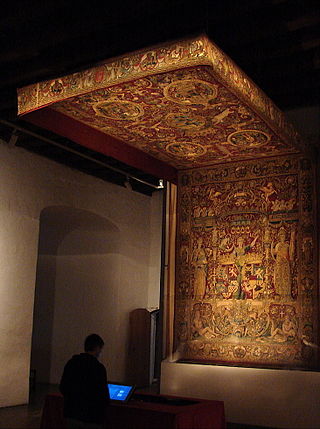
Domenicus Verwilt (sometimes ver Wilt) was a Flemish painter active in Sweden.

Domenicus Verwilt (sometimes ver Wilt) was a Flemish painter active in Sweden.
According to the RKD he is known for portraits and historical allegories. [1] Though his birth and death dates are uncertain, he is registered working in Antwerp from 1544 to 1555 and in Sweden between 1556 and 1566, where he became court painter to Eric XIV of Sweden. [1] He probably knew the portrait painter Steven van der Meulen from his period in Antwerp, who also visited the court of Eric XIV and made a painting of him in 1561.

Jan Gossaert was a French-speaking painter from the Low Countries also known as Jan Mabuse or Jennyn van Hennegouwe (Hainaut), as he called himself when he matriculated in the Guild of Saint Luke, at Antwerp, in 1503. He was one of the first painters of Dutch and Flemish Renaissance painting to visit Italy and Rome, which he did in 1508–09, and a leader of the style known as Romanism, which brought elements of Italian Renaissance painting to the north, sometimes with a rather awkward effect. He achieved fame across at least northern Europe, and painted religious subjects, including large altarpieces, but also portraits and mythological subjects, including some nudity.

Jacob van Schuppen was a French-Austrian painter who was known for his portraits, history paintings and genre scenes. He was court painter in Vienna.

Pieter Boel or Peeter Boel was a Flemish painter, printmaker and tapestry designer. He specialised in lavish still lifes and animal paintings. He moved to Paris, where he worked in the gobelin factory and became a painter to the king. Pieter Boel revolutionized animal painting by working directly from live animals in a natural setting. He thus arrived at representations of animals showing them in their natural, characteristic poses. He had many followers in France.

Jan van Kessel the Younger or Jan van Kessel II, known in Spain as Juan Vanchesel el Mozo or el Joven, was a Flemish painter who after training in Antwerp worked in Spain. Known mainly for his portraits he became a court painter to the King and Queen of Spain. A few landscapes and mythological and allegorical scenes have also been attributed to him. He was formerly believed to have been active as a landscape painter, but this is now no longer generally accepted.

Cornelis van Poelenburgh or Cornelis van Poelenburch, was a Dutch landscape painter and draughtsman. He was the leading representative of the first generation of Dutch landscape painters who were active in Rome in the early 17th century. He was known for small-scale paintings depicting Italianate landscapes with small figures enacting biblical or mythological scenes or in contemporary attire.

Hendrik van Steenwijck II (c.1580–1640) was a Baroque painter mostly of architectural interiors, but also of biblical scenes and still lifes.

Steven van der Meulen was a Flemish artist active c. 1543–1563. He gained prominence in England in the first decade of the reign of Elizabeth I as one of many Flemish artists active at the Tudor court.

Francois (Frans) Verwilt was as a Dutch Golden Age landscape painter.

Willem Adriaensz Key was a Flemish Renaissance painter.

Abraham de Vries was a Dutch painter who was one of the leading portraitists of his age. As he led a peripatetic lifestyle and worked in France, Antwerp and the Dutch Republic his stylistic qualities are difficult to pin down.

George Geldorp, Georg Geldorp or Jorge Geldorp was a Flemish painter who was mainly active in England where he was known for his portraits and history paintings. He was also active as an art dealer and impresario.

Pieter Isaacsz was a Danish court and portrait painter from Dutch origin who worked in a mannerist style on historical, biblical and mythological subjects. He was also a tapestry designer and art-dealer who spied for both the Netherlands, Denmark, and, eventually, for Sweden.

Franciscus de Neve (I) (1606 in Antwerp – 1681 or 1688 in Antwerp or Brussels) was a Flemish painter of history paintings, landscapes and portraits.

Gortzius Geldorp (1553–1618) was a Flemish Renaissance artist who was active in Germany where he distinguished himself through his portrait paintings.

Jacob van Doort (-1629) was a painter of Flemish or Dutch extraction active in portrait miniatures from 1606 to his death in 1629. He did much of his work for the courts of Denmark and Sweden, in particular the court of Christian IV of Denmark.

Catarina Ykens or Catarina Ykens (I) (née Floquet) (1608/1618 – after 1666) was a Flemish still life painter. She is known for flower and fruit garland paintings and vanitas paintings.

Jan Josef Horemans the Elder (1682–1759) was a Flemish painter of the 18th-century. He was mainly known for his genre scenes but he also painted portraits and historical allegories.

Hans Knieper was a Flemish painter and draughtsman.He became a court painter and tapestry cartoon designer at the Royal Danish Court and ran a tapestry weaving shop in Denmark.

Catarina or Catharina Ykens or Catarina Ykens (II) (1659–1737 or later) was a Flemish painter. The few surviving paintings attributed to her are still lifes but she is also believed to have painted history paintings with biblical themes.

Jan Josef Horemans the Younger was an 18th-century Flemish painter. He is mainly known for his genre scenes but also painted harbor views, equestrian paintings, portraits and still lifes.